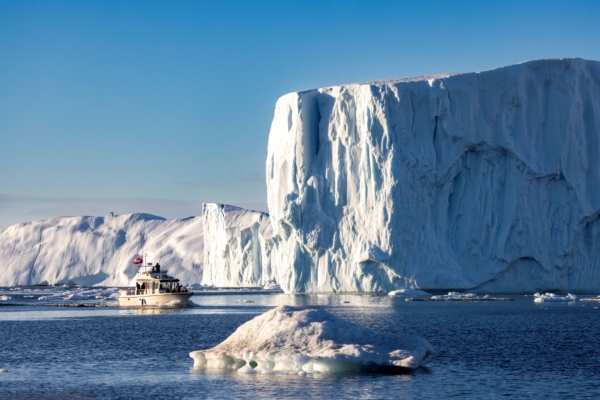Is there gold hidden in the ice of Greenland? Entrepreneurs are flocking to this Arctic island, extracting its abundant resources, hoping that enough people will be willing to pay higher prices for vodka made with glacier meltwater or cocktails mixed with Greenlandic ice cubes.
According to The Wall Street Journal, the ice cubes from Greenland are promoted as cleaner and denser than most ice cubes because they have been compressed in glaciers for 100,000 years before falling into the fjords. However, the scientific validity of this promotion, as well as the environmental cost of transporting ice from the Arctic to nightclubs in Dubai, are both subjects of controversy.
Entrepreneurs are betting that there will be enough people willing to pay $218 for a glass of chilled drink or a glass of Scotch whisky.
Greenland has announced that it has opened for commercial operations.
Arctic Ice Company, a startup established two years ago, captures car-sized drifting icebergs from a fjord in western Greenland, cuts them with a chainsaw, loads the ice cubes into refrigerated containers, then onto cargo ships for a five-week, 10,000-mile journey across the sea. An employee of the company transfers crushed ice into specially designed containers to maintain its purity during storage and transportation.
Co-founder Ittu Lilliendahl, a local Greenlander, searches for icebergs broken off from inland glaciers that flow into the waterways, requiring about six hours by boat from the capital Nuuk.
“We look for the clearest ice at the bottom of the inland ice sheet because that is the oldest and cleanest part,” Lilliendahl said.
After the containers arrive in Dubai, workers from Arctic Ice Company carve the ice into spheres and place them in triangular gift boxes along with a small pair of tongs, selling the gift box of six ice cubes for $100.
At Nahaté Dubai, a restaurant in Dubai’s financial district, diners can enjoy the “Desert Whispers” cocktail served ice-chilled with Greenland ice cubes for 175 dirhams (about $48).
The marketing director of Nahaté Dubai restaurant said, “Storytelling is very important for customers; when you tell them that these ice cubes contain elements from 100,000 years ago, they are very touched.”
Valentin Pinault, a 28-year-old French entrepreneur living in Dubai, enjoys using Greenland ice cubes to mix with his 18-year-old single malt Scotch whisky, sold for 800 dirhams or about $218 at Nahaté. He appreciates the purity of the ice cubes, as they are devoid of any dirt or bacteria and melt slowly.
“It makes your drink cool without diluting it too much,” Pinault said. “It’s very pure.” He read a news report about this ice cubes last October.
Mathieu Morlighem, a glaciology professor from Dartmouth College, explains that as snow falls on the ice sheet, it forms annual layers similar to tree rings, which are compressed over time.
Morlighem mentions that Greenland’s glaciers flow from the inland ice sheet to coastal waterways, making it nearly impossible to determine the age of this ice.
Thomas Olsen collects and transports glacier meltwater from southwestern Greenland to the Jutland Peninsula in Denmark, where it is distilled into gin and vodka under the brand Point 660, sold for around $68 per bottle.
The newly elected government of Greenland is in the process of drafting legislation to attract more ice and water collection companies. The new regulations will streamline permit approvals and improve roads and ports.
According to a 2024 report by the National Oceanic and Atmospheric Administration (NOAA), the warming rate in Greenland and other Arctic regions has been three times the global average since 1980, with Greenland losing an estimated 270 billion tons of ice annually.
Samir Ben Tabib, co-founder of Arctic Ice Company, intends to ship 20 to 30 containers to Dubai once the seasonal ice around the coast begins to melt in May. The company is even considering entering the bottled water industry.
A study suggests that the global ice market size is expected to reach $7.23 billion by 2027.
Seafood exports account for 90% of Greenland’s exports, followed by minerals, but the prospects for water and ice exports are promising, with transportation costs being the primary economic hurdle to expanding water and ice projects.
Javier Arnaut, a professor of social sciences and economics at the University of Greenland, says, “This is a great example of how to start a business and build community pride here, but at the same time, is ice truly a necessity that the world needs?”

